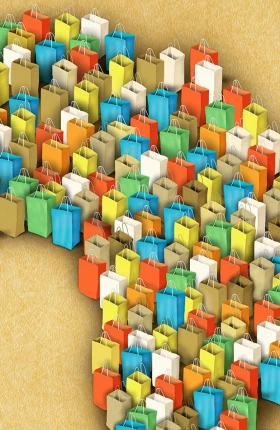Africa is not easily pigeonholed, and making generalizations about its consumers is a risky proposition. The continent has 1 billion inhabitants—speaking more than 2,100 languages and spanning 54 countries that cover an area larger than China, the U.S., India, and Europe combined. Despite this diversity, one thing is clear, however: a new consumer class is emerging across Africa—one with increasing purchasing power and a hunger for products and services that once seemed unattainable. For forward-looking companies, these growing markets will be worth well over $1 trillion by 2020 and will offer access to millions of new customers.
Through our extensive work and travel across the continent, we’ve met and talked with many of these new consumers about their dreams and desires, as well as their product and brand preferences, purchasing habits, and other consumer behaviors. We were struck by ten characteristics that these consumers shared in common; each has implications for multinational and local companies.
1. Optimism About the Future—and a Sense of Progress
Over the past ten years, growth in Africa’s GDP has surpassed worldwide averages, fueling optimism and a sense of progress among consumers on the continent. Consistently, African consumers shared phrases such as, “This generation has it much better than our parents’ generation did,” and “The economy is much better today.” Urbanization is one factor driving progress and opportunity. As one young man told us, “My life today is better than life was for my parents...they lived in villages, we live in cities. City life is much better: cities have amenities, more development, more knowledge.” Although we understandably found less-optimistic consumer sentiment in regions that have experienced political turmoil over the past two years—in North Africa for example—the vast majority of Africans believe that tomorrow will be better than today.
Africa’s growing national economies, rising incomes, and expanding urbanization are fueling increases in consumption. Many Africans we spoke with expressed near-term plans to buy laptops; upgrade their mobile phones; and spend more on entertainment, homes, cars, and education. This desire for more is reflected in the data on African consumption, a phenomenon that is emerging across all major product categories and a trend that is expected to continue. Moreover, as incomes increase, urban African consumers are exploring new product categories and upgrading to more expensive versions of products. These trends indicate significant growth opportunities for many multinational companies.
2. Entrepreneurial and Ambitious
Africa’s higher-education system is insufficient; less than 10 percent of the population is enrolled in universities, and only four universities are ranked among the top 400 institutions worldwide. Despite a growing presence from multinational companies and the recent emergence of the so-called African Challengers—well-structured African corporations with regional ambitions—Africans lack structured career paths within the private sector. Consequently, many Africans create their own opportunities and boast proudly about them; for example, interviewees told us “I’m planning to start my own agriculture research company,” and “We’re sourcing T-shirts from China and selling them to local businesses.”
Although hiring and retaining talent are often considered the biggest challenges for companies willing to grow in Africa—and have been the top priority investment for most successful multinationals such as Coca-Cola, Unilever, Nestlé, and Maersk—companies can both leverage this entrepreneurial spirit and look to local entrepreneurs to aid in product distribution and promotion.
3. Active Users of the Internet and Technology
Technology, the Internet, and corresponding access to information are seen as the biggest drivers of change for this generation relative to previous ones, especially over the past ten years. These drivers serve as a clear enabler of Africa’s improved political and economic stability. “Life is easier now that we have technology,” said one young man.
Mobile technology in particular is enabling the continent to overcome its lack of infrastructure; it also has changed the game by enhancing consumers’ access to information and knowledge. Many African consumers are prolific users of computers, smartphones, the Internet, and social media; in fact, mobile phone and Internet usage and penetration are disproportionately high in Africa and growing rapidly. Studies show that some Africans are even skipping meals so that they can afford their mobile airtime. Social networks are important, and the use of Facebook, Twitter, LinkedIn, and other sites is on the rise.
Viral communication is becoming increasingly critical for reaching African consumers. As a result, multinationals should look for ways to leverage the Internet and social media to advertise, provide product information, create buzz to build brand awareness, and educate consumers.
4. Desiring International Brands
African consumers know, love, and purchase international brands. During our interviews, we met Africans who use Blackberrys, watch Sony flat-screen TVs, drink Coke and Pepsi, and eat Doritos. In some cases, international brand names have become the common terms for categories of products; for example, detergents in Morocco are frequently referred to as “Tide,” and razors in the Democratic Republic of Congo are commonly called “Gillette.”
One might conclude that the long-standing relationships between many African countries and Europe—as well as the broad exposure that African consumers have had to Western culture—are the driving forces behind this attachment. (Consider that many Africans told us that they watch European television programs and root for European soccer teams such as Real Madrid and Chelsea Football Club.) Or one might conclude that African consumers perceive their local brands to be of lower quality than international ones, which prevents the local brands from achieving larger scale.
But, in reality, the opportunities for international brands to achieve success in Africa lie more in the structure of the regional markets and brands. In contrast to China and India, where local brands have achieved broad scale, Africa isn’t yet home to any local brands that truly span the continent. Instead, African brands typically are country specific, focused on one market, lack access to the critical mass needed to transform a local brand into a major one, and often receive insufficient investment in their expansion from management—either by choice or because of funding shortfalls.
Therefore, international companies can build on their brand advantage now, while African markets remain less competitive than other regions. As competition heats up, traditional Western brands should note that African consumers increasingly turn to leading brands from Asia, Turkey, and Brazil.
5. Highly Loyal to Brands
Surveys show that African consumers are highly brand loyal—more so than their Asian counterparts. “I only try brands I know, brands I am familiar with” was a common sentiment expressed. When incomes are tight, consumers are more reluctant to risk trying new products that they might not like and tend to stick to their brand preferences, which they typically inherit from trusted family members, friends, and peers.
In this context, companies have two options. First, they can leverage the “umbrella effect” (African consumers tend to extend their brand preferences to families of products) by creating product extensions and new varieties. Second, they can fight consumers’ reluctance to switch from the tried and true with effective promotions and marketing campaigns; samples are very effective here too, so companies should let consumers taste, touch, feel, and use products.
In all cases, companies shouldn’t limit marketing efforts to consumers who can afford products today. Aspirational brands often become the brands of choice when incomes rise. And although the hurdle for new product penetration is higher in Africa than in China and other countries, once companies win over an African customer, they will likely hold onto that customer for life.
6. Willing to Pay for Quality
Even though many African consumers have limited budgets, the cheapest products aren’t always the winners. Instead, African consumers insist on the right balance of high quality and price. “I’d rather not give the kids something just because it’s cheap and they want it. I’d rather give them something of good quality,” one mother said.
In fact, companies with premium products are winning. Indian motorcycle manufacturer Bajaj Auto entered Nigeria with its Boxer motorcycle. Priced 30 percent higher than Chinese models, Boxer won over the market in two years and is now the best-selling motorcycle in Africa.
African consumers associate price with product quality. In particular, they are willing to pay more for a higher quality product and, in the case of consumer durables, for products that will last longer. Many will find a way to buy higher-priced, quality items, even if they must save for several months or pool their money with friends and family. The long lead-times that frequently result for the purchase of big-ticket items minimize impulse buys—and allow consumers to research products online, ask advice from family and friends, and speak with store owners and shop assistants.
To win in Africa’s markets, companies can’t assume that any international product will be an automatic hit. Instead, multinationals must understand consumer preferences and strike the right balance between quality—notably, durability—and price. This may mean that companies opt to design products specifically for emerging markets, as Samsung did by creating televisions with built-in power surge protectors, and as Renault did with its low-cost, high-quality Dacia automobile. Moreover, companies must emphasize the quality of their products and reinforce that message through sampling, advertising, and marketing. Educating sales people and store owners—who are trusted influencers at the point of sale—can also be an effective route.
7. An Underestimated Market Potential
Although our understanding of African consumers is growing, specific data and insights are still lacking. Consumer research and data-mining companies maintain a minimal presence on the African continent, and the scattered information on markets, consumers, and categories that is available is sometimes unreliable. When it comes to market sizes, massive discrepancies commonly exist between publicly available data and the actual numbers found by field surveys. In many cases, the size of the African markets is almost always understated, primarily because parallel imports and informal sectors aren’t included in the “official” numbers.
The implications are threefold. First, multinational companies should not underestimate Africa’s market potential; instead, they should dig deeper to size the markets accurately. Second, multinationals should be ready to invest in order to build a solid understanding of the relevant market—they should not expect to find off-the-shelf market data. Third and finally, companies should expect to fight against parallel imports and informal sectors if they want to reap the full potential of the African consuming markets.
8. Saving, Sharing, and Supporting One Another
Many African consumers are used to living in volatile environments, typically without a safety net and with little or no access to credit. As a result, those who can are saving some portion of their incomes—as much as 40 percent in some cases. These habits tend to be more entrenched in the regions that have volatile climatic conditions that make saving and stocking food deeply rooted in the local culture.
Pooling money and sharing purchases is also common. “We pool our money to buy the bigger sizes at the supermarket,” said one woman. Some people we spoke with support an extended family, sending a percentage of their earnings to a parent or other family member. One young man told us, “I feel responsible for my mom and sisters. Whenever they need something and I can help, I help.” Others find their purchasing power increased through the remittances sent by family members who have emigrated.
Given these characteristics of the African consumer, companies may want to develop and promote financial products that make it easy for people to save, to share, and to support one another: among these are savings accounts, mobile money transfers, and insurance policies. Also, companies should look for ways to associate their brands with family and community through marketing.
9. Evolving Retail Preferences
With their variety, low prices, larger sizes, quality, freshness, and cleanliness, modern retail stores and supermarkets similar to those found in the U.S. and Europe are beginning to dazzle urban African consumers in some countries. Said one young mother, “I only go to the supermarket—it has the best variety and lowest prices. Why go anywhere else?”
Consumers and brand manufacturers alike gain significant benefits from these stores: international brands prevail; more shelf space means a greater variety of products and sizes; the browsing and handling of products is enhanced; the wide aisles and good lighting offer a pleasant shopping experience; signage, displays, and end caps allow for more effective product promotion; and products are highly visible rather than ordered from a back room, hidden in boxes, or stuffed behind other products.
Although modern trade is growing and expected to gain share in urban areas, the traditional trade outlets still largely dominate sales since they reach more of Africa’s population and tend to be more conveniently accessible for shoppers. As one man commented, “I do my main shopping at the supermarket. It has more variety and is cheaper. But if I just want something quickly, I still go to the corner [traditional] shop.”
To succeed in these markets, multinationals must use a two-pronged strategy that targets both traditional and modern retail outlets to maximize consumer touch-points. First, success in traditional outlets requires small pack sizes, small displays, and signage. Store visits can be an effective way to educate store clerks by providing them with product information. And the right incentives can encourage these same clerks to promote products to shoppers. Second, in some countries, the progressive growth of modern trade offers an opportunity for new entrants to attack incumbent brands with a channel-focused strategy, as existing brands may struggle to please all channels at the same time.
10. Despite Progress, Some Challenges Remain
Although Africa offers significant growth opportunities, many challenges remain. While incomes are rising, a sizeable portion of the population is still living in poverty. Therefore, in many cases, an adapted product portfolio—offering affordable product sizes, the right price-quality mix, and thoughtful communication messages—remains the key to brand penetration and brand loyalty among lower-income consumers.
Moreover, while urbanization is increasing, a majority of Africans still live in rural areas or small villages and towns. Distribution to this “last mile” is difficult, given that only 19 percent of the roads are paved, and 70 percent of the continent’s rural population lacks access to all-season roads. New distribution models will be needed to reach these consumers—and multinationals will have to find ways to extend their supply chains through the help of local partners.
Such approaches will fail if companies simply “hand off” products to third-party distributors without any follow-up. Instead, they require understanding consumer access points, finding and supporting distributors that can reach remote areas, and monitoring presence, pricing, and perceptions through an enhanced and ongoing local presence.
The era of trading posts is over: to win in twenty-first-century Africa, companies will need to become truly local by building a complete ecosystem of local suppliers, locally adapted product portfolios, local teams, local distributors, and local market intelligence.





